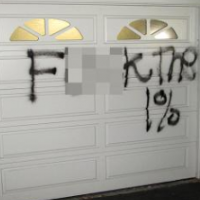Class War Erupts in Silicon Valley: FBI Asked to Join the Hunt for Graffiti Artists
 (photo: NBC screen grab)
(photo: NBC screen grab)
The “One-Percent” are under assault in Atherton, California, one of the wealthiest enclaves in the country, prompting an appeal for help from local authorities to the Federal Bureau of Investigation (FBI)
It is not clear how successful the bureau has been at solving graffiti cases in the past—nor is it clear if they’ll play a role in this one—but the spray painting of nine homes and a car with testy slogans like “Fuck the 1%” have garnered national attention.
Atherton Police Lieutenant Joe Wade told the San Francisco Chronicle that the February 16 vandalism incident might just be some teens goofing around or be part of a larger protest against wealthy people. Just to be safe, Atherton reached out to other law enforcement agencies, including the FBI, to find the bad guys before they strike again.
“Sometimes the FBI will monitor protest groups and things of that nature,” Wade told the San Jose Mercury News. Yes, they do.
Silicon Valley’s profile has risen in recent weeks as some of its more illustrative billionaires have spoken out against growing resentment in the country over increasing income inequality. Venture capitalist Tom Perkins wrote a letter to the Wall Street Journal in January comparing attitudes toward, and treatment of, the 1% of Americans who control most of the nation’s wealth to what the Nazis did during the Holocaust.
He likened the hateful activities of the American underclass to Kristallnacht, the infamous 1938 Night of Broken Glass Nazi attacks generally regarded as kicking of the eventual extermination of 6 million Jews. Powerless poor people = Nazi overlords.
That didn’t help matters.
A 2013 Pinterest home tour of “Famous People Around Silicon Valley” included Atherton denizens Charles Schwab, Hewlett-Packard CEO Meg Whitman, Google Chairman Eric Schmidt, Facebook CEO Sheryl Sandberg, Microsoft billionaire Paul Allen and Hall of Fame football player Jerry Rice.
Forbes said the cheapest home in Atherton last October had a $1.2 million pricetag. That kind of money buys you a 2-bedroom, 1,194-square-foot bungalow. That might not be as attractive to graffiti artists as the city’s most expensive home, which was tagged at $33 million. Forbes said Atherton’s zip code, 94027, was the most expensive in the U.S., based on the median price of 50 homes—$6.67 million—offered for sale last summer.
Rising income inequality has been a fact since the 1980s. For decades, the conventional wisdom has been that the growing gap is irrelevant as long as economic growth continues and a rising tide raises all ships.
The Great Recession put a magnifying glass on that theory. The ratio of CEO pay to average worker pay is 273-1 today, compared to 20-1 in 1965. In 2010, the top 10% of earners took home more than half the nation’s total income. That’s a record in the U.S. The richest 10% own 90% of the stock. The total income of the 1% surged 20% in 2012.
It has only been recently that people have been asking if growing inequality is a bad thing. However, that question is still more likely to be posed by graffiti artists and Occupy protesters than talking heads on CNBC or President Barack Obama, who mentioned “inequality” just three times in his State of the Union message.
Outrage over income inequality may not yet have risen to a level that warrants an investigation by the FBI and may, in fact, have already peaked. Timothy Noah at MSNBC has already asked the question: “Is America’s inequality moment over?”
–Ken Broder
To Learn More:
Multimillion-Dollar Atherton Homes Vandalized (by Carolyn Jones, San Francisco Chronicle)
Graffiti Targeting the “1 Percent” Spray-Painted in Atherton Neighborhood (by Bonnie Eslinger, Bay Area News Group)
Anti-Wealthy Graffiti Hits Atherton (by Chris Roberts, NBC Bay Area)
Has Occupy Movement Come to Silicon Valley? Vandals Strike Atherton (by Jessica Guynn, Los Angeles Times)
The Increasingly Unequal States of America (by Estelle Sommeiller and Mark Price, Economic Policy Institute)
- Top Stories
- Controversies
- Where is the Money Going?
- California and the Nation
- Appointments and Resignations
- Unusual News
- Latest News
- California Forbids U.S. Immigration Agents from Pretending to be Police
- California Lawmakers Urged to Strip “Self-Dealing” Tax Board of Its Duties
- Big Oil’s Grip on California
- Santa Cruz Police See Homeland Security Betrayal in Use of Gang Roundup as Cover for Immigration Raid
- Oil Companies Face Deadline to Stop Polluting California Groundwater





